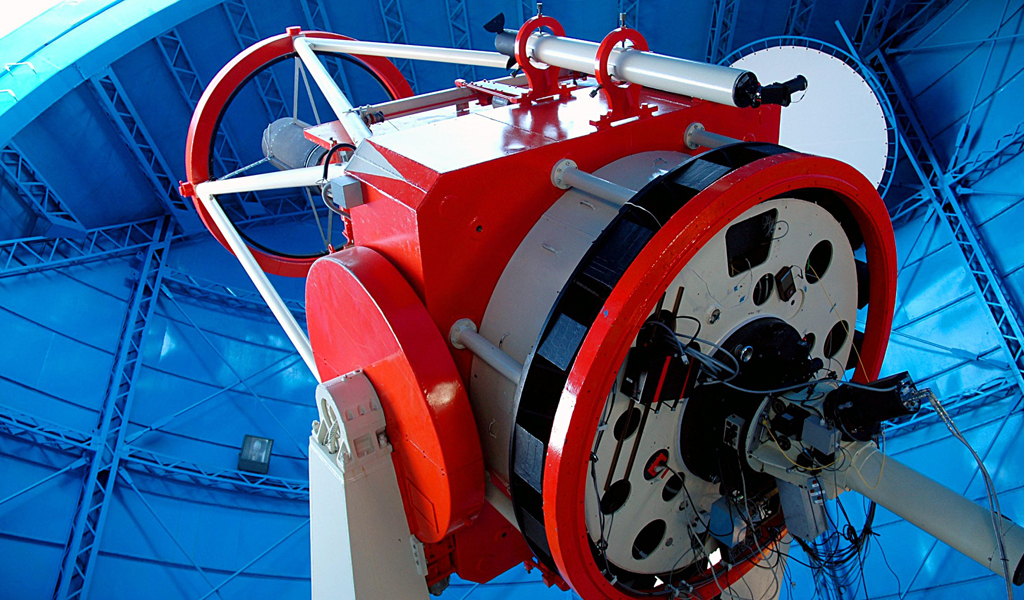


 Optical spectra of Near-Earth asteroids (NEAs) and Main-belt asteroids are obtained with the 2.1m telescope of the "Guillermo Haro" Astrophysical Observatory (OAGH), in Cananea, Sonora, Mexico, using a Boller & Chivens spectrograph with a Site600 1024 x 1024 pixels CCD. The main goal of this observations is to determine the taxonomic class to which each of the observed objects belongs.
Optical spectra of Near-Earth asteroids (NEAs) and Main-belt asteroids are obtained with the 2.1m telescope of the "Guillermo Haro" Astrophysical Observatory (OAGH), in Cananea, Sonora, Mexico, using a Boller & Chivens spectrograph with a Site600 1024 x 1024 pixels CCD. The main goal of this observations is to determine the taxonomic class to which each of the observed objects belongs.
A low-resolution diffraction grating of 50 l/mm, which provides a dispersion of 9.9 Å/pix, and a spectral coverage in the range 4000 - 10000 ÅÅ was used. Because of low signal-to-noise ratio, the spectra were truncated below 4500Å and past 9200Å. Due to the large sky motion of some observed NEAs, and in order to minimize the effects of atmospheric differential refraction, and to reduce the loss of light, a slit width of 400 microns was selected. With a plate scale of 8.18 arcsec/mm in the focal plane of the telescope, it corresponds to 3.2 arcsec in the sky. The observations was made placing the objects in the center of the slit, making the most of the light from the objects passes throughout the slit. In addition, the Boller & Chivens spectrograph is equipped with a camera that view the slit plane, small corrections to the guiding allowing to control that the objects are inside the slit.
The image reduction was performed using the standard Image Reduction and Analysis Facility (IRAF) packages to reduce long-slit spectra. Bias correction was made by subtracting the average bias level of many bias images taken during the night. The normalized median flat field image was produced from several halogen lamp images taken at the telescope dome. Pixel-to-pixel variations were removed by dividing bias corrected images by this flat field image. Cosmic rays were removed by shifting (in the case it was necessary) and combining the three spectra of each object. Few remaining cosmic rays were eliminated by averaging the values of the neighboring pixels. Wavelength calibration was performed using a He-Ne-Ar lamp. After that, the sky subtraction was made. The next step in the reduction process was the extraction of 1D spectra, which were corrected for air masses by using the mean atmospheric extinction law of OAGH.
To remove the contribution of sunlight in the NEAs spectra, and to obtain the asteroids relative reflectance spectrum, different solar analogs were observed at airmasses as close as possible to the target airmass.
The extinction corrected spectra of observed NEAs and the corresponding solar analog spectra were normalized at 5500Å (the center of the Johnson V band), that correspond to a region of asteroid spectra that shows no spectral features. The relative reflectance spectra of observed NEAs were obtained by dividing the object spectrum by the corresponding solar analog spectrum. In order to check if there is a possible influence of different solar analogs on the resulting spectra, we obtained reflectance spectra of each object dividing them not only by the corresponding solar analog, but also by the other stellar spectra taking during the night. Negligible differences (less that 5% in the slope between 0.5 and 0.7 microns) were observed, which points to the quality of the data.
The observational circumstances for the observed objects are listed in Table 1 of this section.
A direct way to determine the taxonomic class to which an asteroid belongs is to calculated the "spectral distance" (Yang, et al. 2003a) between the asteroid spectra and some spectral templates. It is defined by:

where Dx is the spectral distance between the unclassified spectrum X and a classified spectrum Y (spectral template), n represents each of the individual selected points in the spectra to find the best fit between X and Y, and k is the total number of points using in the fitting procedure. The method is well described in Yang, et al. 2003b.
To determine the taxonomic class of observed NEAs, we calculate the spectral distance between the observed object and 1341 asteroids of SMASSII database (Binzel, et al. 2001; Bus & Binzel 2002), searching for asteroid spectra showing smaller values of Dx.
To achieve the best fit between our spectra and the asteroid spectra from the SMASSII database, and before calculating the spectral distances, we produced a smoothed spectra of observed NEAs, after a uniformly rebinning to a dispersion of 30Å (a factor of 3, taking into account that our dispersion is about 9.9 Å/pix). This increases the Signal-to-Noise ratio and reduces the possibility of wrong classification due to the noise or missing data points.
The results of our taxonomic classification of observed objects are shown in Tabla 2 of section “Spectroscopic results”.
| Number | Name | Coordinates | Exp. Time | V (mag) | AU | r (AU) | Ph (degrees) | H (mag) | D (km) |
|---|---|---|---|---|---|---|---|---|---|
| 3103 | Eger | 01:40:54.0 -04:17:46 | 3x900 | 14.3 | 0.194 | 1.079 | 65.7 | 15.38 | 2.97 |
| 378610 | 2008 FT6 | 01:44:57.2 -00:27:40 | 3x900 | 17.4 | 0.520 | 1.509 | 7.4 | 17.4 | 1.17 |
| 248083 | 2004 QU24 | 01:50:30.2 -07:21:10 | 3x900 | 17.4 | 0.762 | 1.733 | 10.9 | 16.1 | 2.14 |
| 171819 | 2001 FZ6 | 01:51:42.2 +20:33:20 | 3x900 | 17.6 | 0.411 | 1.402 | 6.2 | 18.4 | 0.77 |
| 185851 | 2000 DP107 | 02:10:08.6 +34:29:08 | 3x900 | 17.2 | 0.314 | 1.289 | 18.2 | 18.2 | 0.81 |
| 462659 | 2011 DU | 03:27:04.7 -02:48:57 | 3x900 | 16.9 | 0.083 | 1.069 | 26.7 | 21.0 | 0.22 |